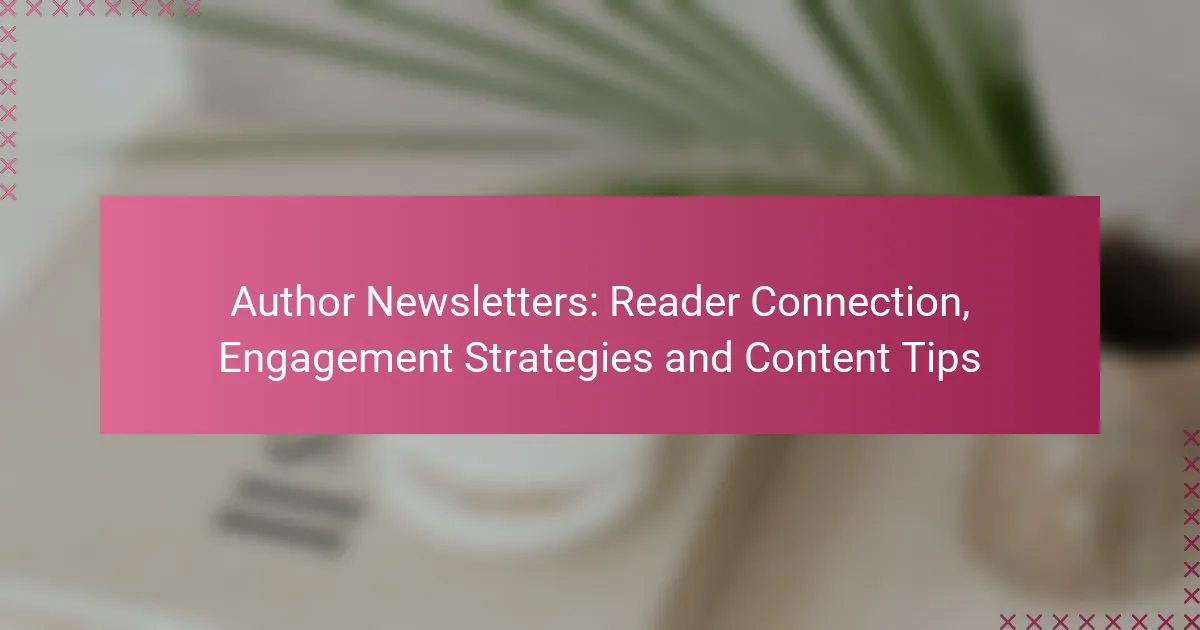Author newsletters are a powerful tool for enhancing reader connection and fostering community. By delivering personalized content and utilizing interactive strategies, authors can engage their audience on a more intimate level, ultimately improving overall engagement rates. Focusing on meaningful and resonant content is key to creating a successful newsletter that captivates readers.
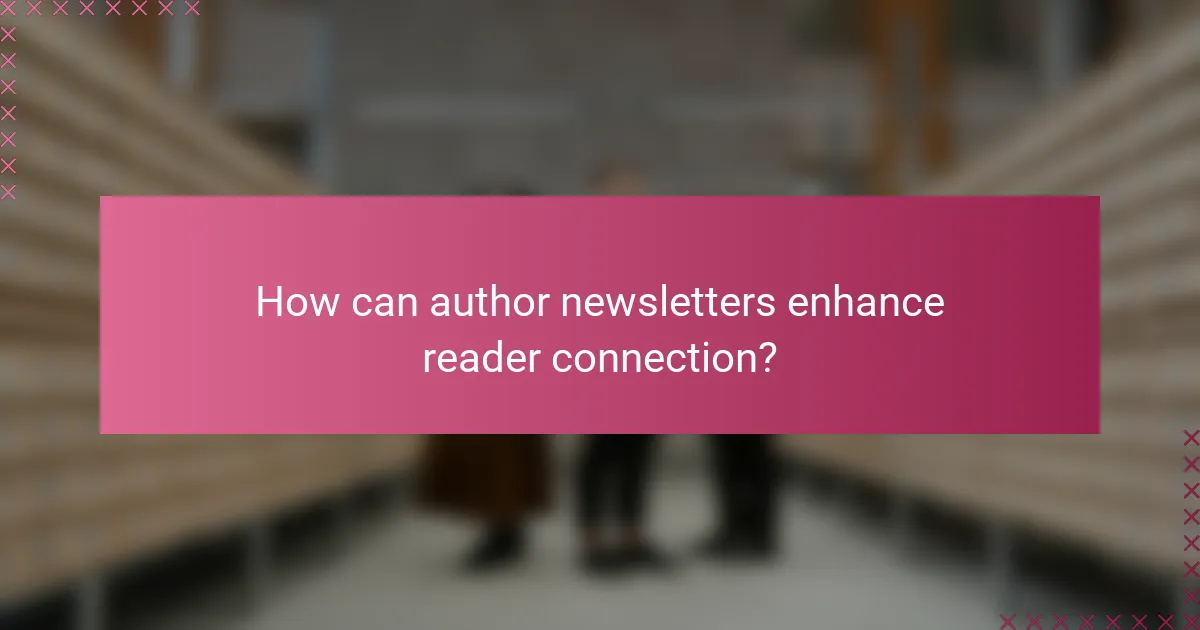
How can author newsletters enhance reader connection?
Author newsletters can significantly enhance reader connection by providing personalized content and fostering a sense of community. They serve as a direct line of communication, allowing authors to engage with their audience on a more intimate level.
Personalized content strategies
Personalized content strategies involve tailoring newsletter content to meet the specific interests and preferences of your readers. This can include segmenting your audience based on their reading habits or preferences, allowing you to send targeted information that resonates with them.
Consider using data from previous interactions, such as clicks or responses, to inform your content choices. For instance, if a segment of your audience shows interest in mystery novels, you can include exclusive content related to that genre, such as sneak peeks or behind-the-scenes insights.
Building a community through engagement
Building a community through engagement is essential for fostering loyalty among readers. Encourage interaction by asking questions, inviting feedback, and creating opportunities for readers to share their thoughts and experiences related to your work.
Utilize social media platforms to complement your newsletters, creating discussions that extend beyond the email. Hosting virtual events, such as Q&A sessions or book clubs, can also strengthen community ties and make readers feel more connected to you as an author.
Utilizing feedback for improvement
Utilizing feedback is crucial for continuous improvement of your newsletters. Actively seek input from your readers through surveys or direct questions in your newsletters to understand what content they find valuable or what they would like to see more of.
Incorporate this feedback into your future newsletters to ensure they remain relevant and engaging. For example, if readers express interest in more writing tips or personal anecdotes, adjust your content strategy accordingly to meet those demands.

What are effective engagement strategies for newsletters?
Effective engagement strategies for newsletters focus on creating meaningful connections with readers through interactive and personalized content. By utilizing various formats and multimedia elements, authors can enhance reader involvement and improve overall engagement rates.
Interactive content formats
Interactive content formats, such as polls, quizzes, and surveys, encourage readers to participate actively rather than passively consuming information. These formats not only make newsletters more engaging but also provide valuable insights into reader preferences and interests.
Consider incorporating a monthly poll where readers can vote on topics for upcoming articles. This approach fosters a sense of community and gives readers a voice in the content creation process.
Incorporating multimedia elements
Integrating multimedia elements like images, videos, and audio clips can significantly enhance the appeal of newsletters. Visual and auditory content captures attention more effectively than text alone, making it easier for readers to connect with the material.
For instance, including a short video summary of your latest book or an audio excerpt can create a richer experience. Aim to keep videos under two minutes to maintain viewer interest.
Segmenting audience for targeted messaging
Segmenting your audience allows for tailored messaging that resonates with specific groups of readers. By categorizing subscribers based on interests, demographics, or engagement levels, authors can deliver more relevant content that meets the unique needs of each segment.
For example, if you have a diverse readership, consider creating separate newsletters for fiction and non-fiction fans. This targeted approach can lead to higher open rates and increased reader loyalty.
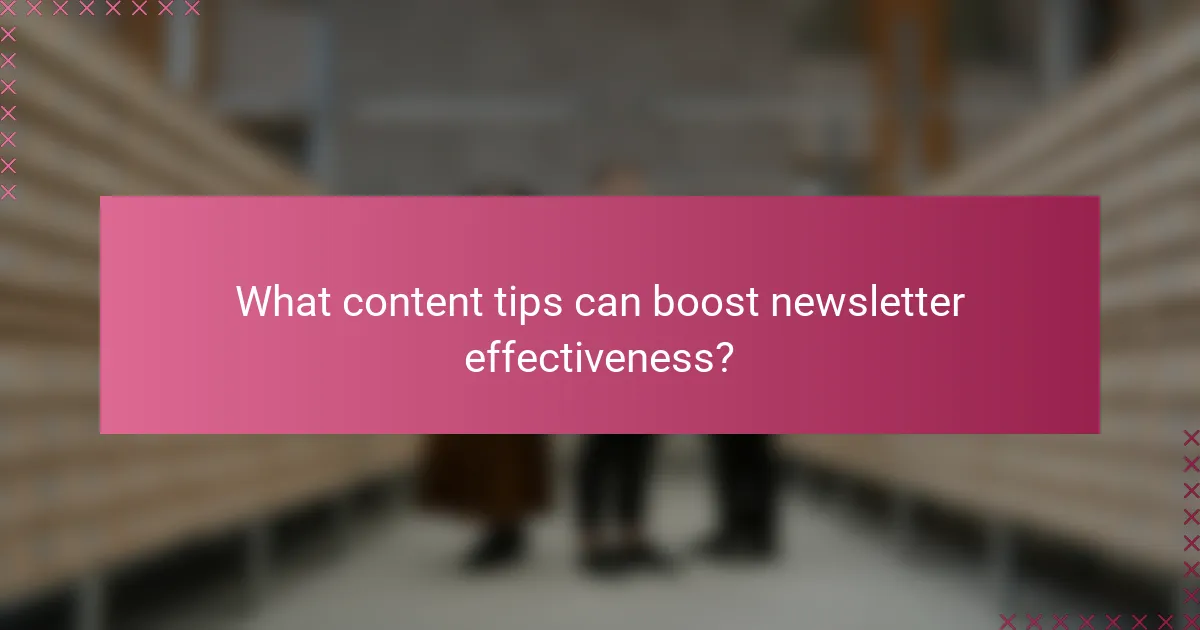
What content tips can boost newsletter effectiveness?
To enhance the effectiveness of your newsletter, focus on creating engaging content that resonates with your audience. Implementing specific strategies can significantly improve reader connection and overall engagement.
Crafting compelling subject lines
Compelling subject lines are crucial for increasing open rates. Aim for clarity and intrigue, using action verbs and personalization where possible. For example, instead of “Newsletter #5,” try “Unlock Exclusive Tips for Your Next Novel!”
Keep subject lines concise, ideally under 50 characters, to ensure they display well on mobile devices. Avoid using all caps or excessive punctuation, as these can trigger spam filters.
Maintaining a consistent tone and style
A consistent tone and style help establish your brand identity and build trust with readers. Define your voice—whether it’s casual, professional, or humorous—and stick to it across all newsletters.
Consider your audience’s preferences when determining your tone. For instance, a light-hearted approach may work well for a fiction writer, while a more formal style might suit a non-fiction author. Regularly review past newsletters to ensure consistency.
Utilizing storytelling techniques
Incorporating storytelling techniques can captivate your audience and make your content more relatable. Share personal anecdotes or case studies that illustrate key points, helping readers connect emotionally with your message.
Use a clear structure: introduce a conflict or challenge, build tension, and provide a resolution. This approach not only engages readers but also encourages them to anticipate your next newsletter. Aim to weave storytelling elements into every edition to maintain interest.
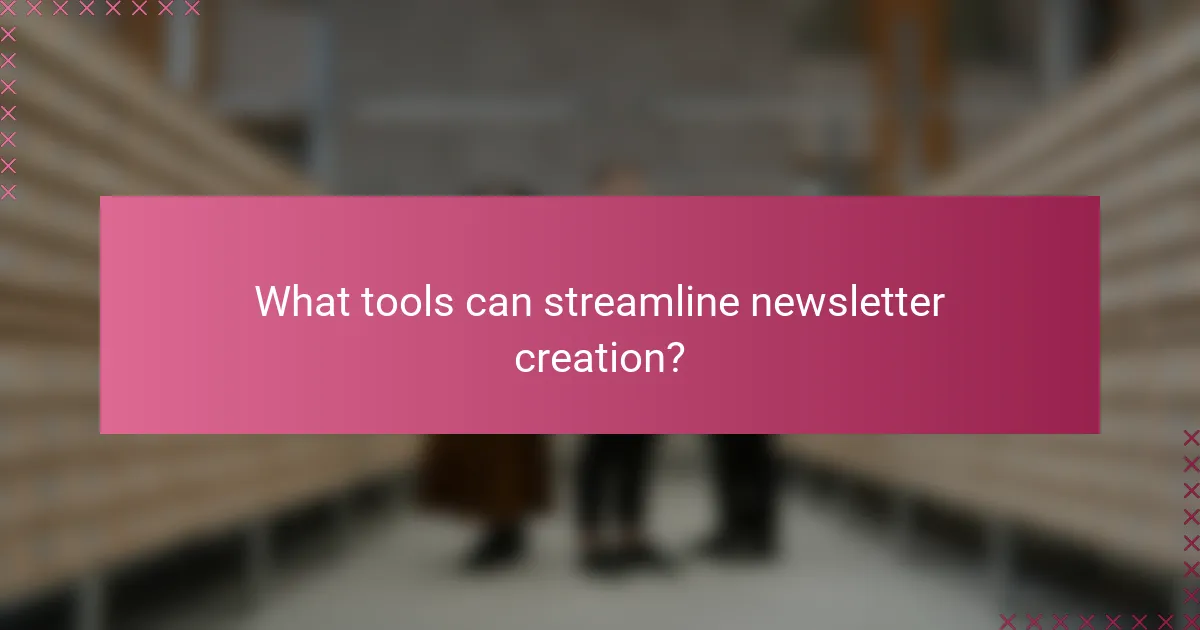
What tools can streamline newsletter creation?
Several tools can significantly enhance the efficiency of newsletter creation, making it easier for authors to connect with their readers. By leveraging automation, design, and performance tracking tools, you can optimize your newsletter process and improve engagement.
Mailchimp for automation
Mailchimp is a popular platform that automates various aspects of newsletter creation and distribution. It allows you to schedule emails, segment your audience, and personalize content based on reader behavior, which can lead to higher engagement rates.
To get started, set up an account and import your email list. Use the automation features to send welcome emails, follow-ups, or targeted campaigns based on user interactions. Be mindful of compliance with regulations like GDPR when handling subscriber data.
Canva for design
Canva is an intuitive design tool that helps you create visually appealing newsletters without needing advanced graphic design skills. With a wide range of templates and customization options, you can easily craft professional-looking layouts that capture your readers’ attention.
When designing your newsletter, focus on maintaining brand consistency by using your logo, colors, and fonts. Keep the layout clean and easy to navigate, ensuring that important information stands out. Avoid cluttered designs that can overwhelm your audience.
Google Analytics for performance tracking
Google Analytics is essential for tracking the performance of your newsletters. By integrating it with your email campaigns, you can gather insights on open rates, click-through rates, and subscriber behavior, allowing you to refine your content strategy.
Set up goals in Google Analytics to measure specific actions, such as newsletter sign-ups or product purchases. Regularly review the data to identify trends and adjust your approach accordingly. This data-driven strategy can help you enhance reader engagement over time.
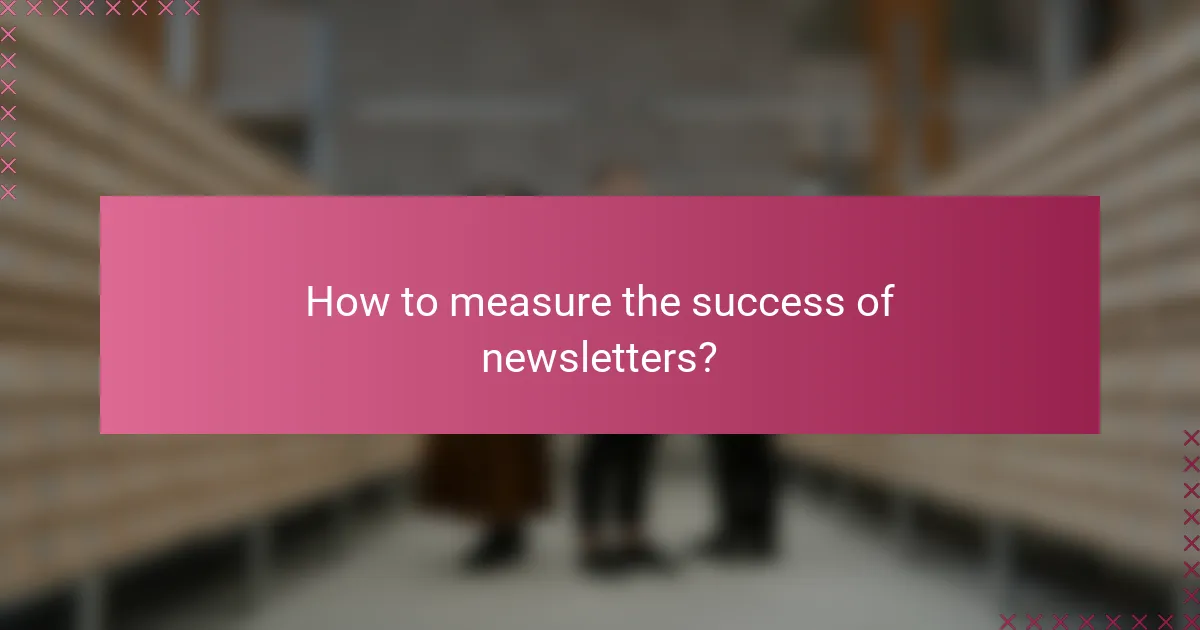
How to measure the success of newsletters?
Measuring the success of newsletters involves tracking key performance indicators that reflect reader engagement and growth. By analyzing metrics such as open rates, click-through rates, and subscriber growth, authors can gain insights into how well their content resonates with their audience.
Open rates and click-through rates
Open rates indicate the percentage of subscribers who open a newsletter, while click-through rates measure how many of those readers click on links within the content. A good open rate typically ranges from 15% to 25%, while click-through rates can vary widely but often fall between 1% and 5% for most industries.
To improve these rates, consider crafting compelling subject lines and ensuring that your content is relevant to your audience’s interests. Regularly testing different approaches can help identify what resonates best with your readers.
Subscriber growth metrics
Subscriber growth metrics track how many new subscribers you gain over a specific period, as well as the rate of unsubscribes. A healthy growth rate might be around 5% to 10% monthly, depending on your niche and marketing efforts.
To foster subscriber growth, promote your newsletter through social media, your website, and other channels. Offering incentives like exclusive content or discounts can also encourage sign-ups while keeping an eye on unsubscribe rates to address potential issues.
Engagement levels through surveys
Engagement levels can be gauged through surveys that ask subscribers about their preferences, interests, and satisfaction with the newsletter. Surveys can provide valuable feedback and help tailor content to better meet reader expectations.
Consider conducting surveys periodically, perhaps quarterly, to keep your finger on the pulse of your audience’s needs. Keep questions concise and focused, and offer incentives for participation to increase response rates.
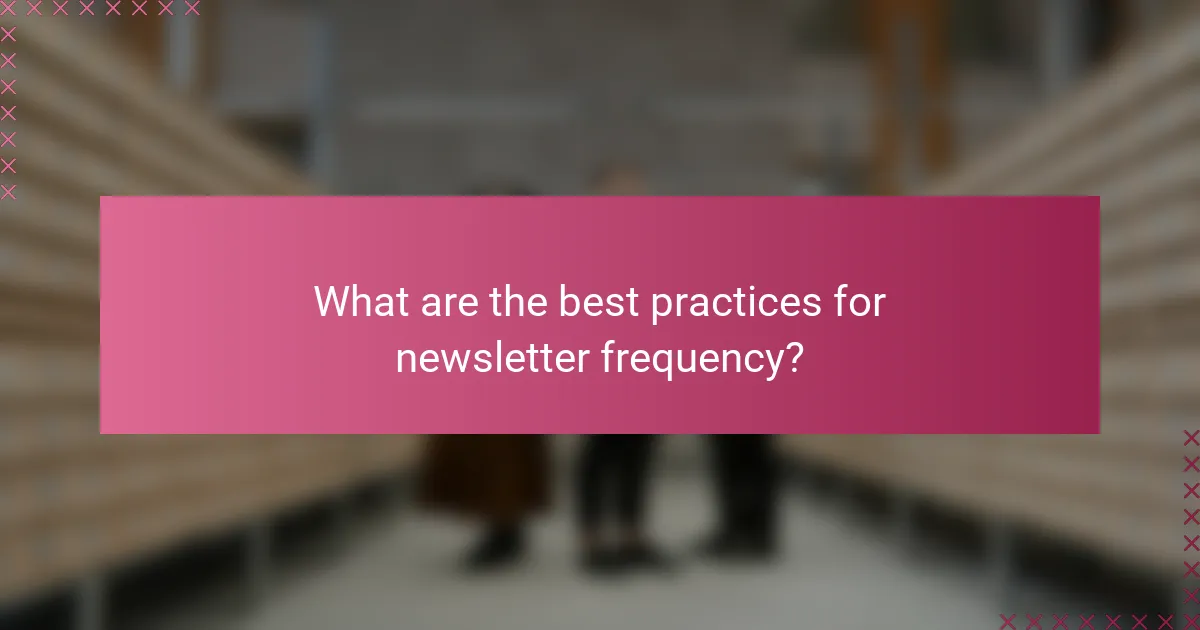
What are the best practices for newsletter frequency?
Finding the right newsletter frequency is crucial for maintaining reader interest and engagement. Generally, a balance between staying relevant and not overwhelming your audience is key.
Weekly vs. monthly distribution
Weekly newsletters can keep your audience engaged and informed, but they require consistent content creation and may lead to subscriber fatigue if not managed well. Monthly newsletters, on the other hand, allow for more in-depth content and can be easier to produce, but they risk losing reader interest over time.
Consider your audience’s preferences and the nature of your content when deciding on frequency. For instance, if your updates are time-sensitive, a weekly schedule may be more appropriate. Conversely, if your content is more evergreen, a monthly approach could suffice.
Timing considerations for audience engagement
The timing of your newsletter can significantly impact open rates and engagement. Research suggests that sending newsletters in the middle of the week, particularly on Tuesdays or Wednesdays, often yields better results than weekends or Mondays.
Additionally, consider your audience’s time zone and typical online habits. For example, if your readers are primarily in the U.S., sending emails in the late morning or early afternoon can align with their lunch breaks, increasing the likelihood of engagement.
